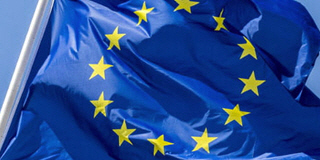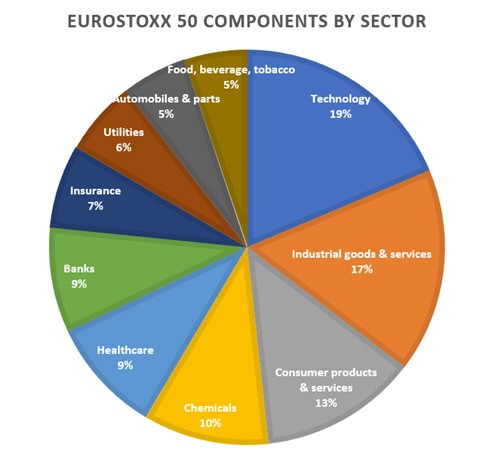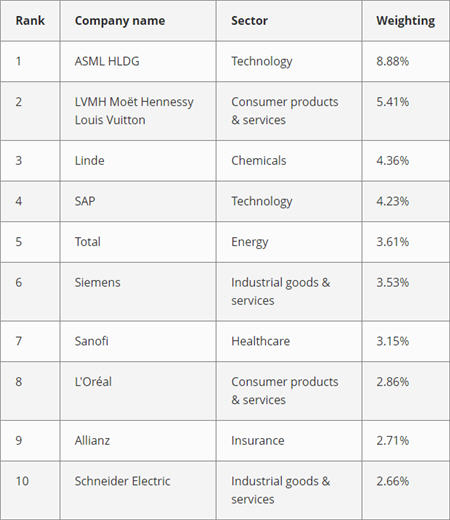Test NanoTrader Full I Test Tradingview I Test the mobile platforms All for CFD-Forex & Futures
You are here
EuroStoxx 50 trading guide: constituents, market hours and how to trade

The EuroStoxx 50 is a major benchmark for stock market performance in the eurozone. Discover more about what moves the EuroStoxx 50 price, the nature of its constituents, and how you can go about trading it. The following topics are covered in this article:
- What is the EuroStoxx 50?
- About EuroStoxx 50 constituents
- How often do EuroStoxx 50 companies change?
- What does the EuroStoxx 50 price mean?
- How is the EuroStoxx 50 calculated?
- What affects the EuroStoxx 50 price?
- Average annual returns of the EuroStoxx 50
- How to trade the EuroStoxx 50
- How to short the EuroStoxx 50
- EuroStoxx 50 companies ranked by market capitalisation
Trading the EuroStoxx 50
What is the EuroStoxx 50?
The EuroStoxx 50 is a stock index traded on the Eurex exchange that tracks the performance of the 50 largest companies listed in eurozone nations. As such, it is a key gauge of market strength and a major equity benchmark that’s watched by investors around the world.
Launched in 1998 by STOXX Limited, a subsidiary of stock exchange operator Deutsche Börse AG, the EuroStoxx 50 is a free-float market capitalisation-weighted index. This means that, like the German Dax or the FTSE 100, companies with a higher market cap are given a greater weighting. The highest-weighted company on the index is Dutch semiconductor operator ASML Holding NV, at 7.74%.
Essentially, the Euro Stoxx 50 tracks the prices of the 50 biggest companies on the wider Euro Stoxx index – which also includes mid and small-cap stocks. The constituents of the Stoxx 50 account for around 60% of the wider index.
Both indices include constituents from Belgium, Finland, France, Germany, Ireland, Italy, Luxembourg, the Netherlands and Spain.
About EuroStoxx 50 constituents
The largest constituents of the index by weighting feature the likes of French luxury goods firm LVMH Moët Hennessy Louis Vuitton and German engineering company Linde. Also among the higher-profile businesses featured in the index are German tech giant SAP and French cosmetics multinational L'Oréal.
Here’s how the EuroStoxx 50 sector composition looked as of September 2021.

How often do EuroStoxx 50 companies change?
The EuroStoxx 50 is reviewed annually in September. The top 40-ranked companies by free-float market capitalisation are selected for inclusion, with the final ten companies selected from the largest current stocks remaining in the 41st to 60th band. If there are still not 50 companies at this point, the largest stocks after point 41 are chosen regardless of current status in the index.
What does the EuroStoxx 50 price mean?
The price of the EuroStoxx 50 indicates whether the share prices of the companies on the index are rising or falling. If the price of the EuroStoxx 50 is increasing, it means that a specific company or group of companies are experiencing gains, which is reflected in the price of the overall index. Conversely, if the EuroStoxx 50 price is falling, it means that companies on the index are experiencing a decline in price.
How is the EuroStoxx 50 calculated?
The EuroStoxx 50 is calculated using a complex equation taking into account the time the index is computed, the number of companies in the index, the current price of each stock, the free-float factor of each stock, the weighting cap, and more. These values are considered in relation to a constant index divisor. The maximum weighting for a EuroStoxx 50-listed company is 10%.
What affects the EuroStoxx 50 price?
The EuroStoxx 50 price can be impacted by a variety of fundamental drivers linked to the performance of the eurozone economy and industries within it, as well as technical factors. European Central Bank (ECB) monetary policy may affect the index price, as well as foreign exchange rates, economic data releases, and even commodity prices. While such drivers may be expected to move the index in a certain direction, there is no guarantee that the move will play out, so traders should consider how determining factors work together rather than simply isolate any one factor. That said, here are a few of the key things to consider when trading the EuroStoxx 50.
Monetary policy and economic releases
European Central Bank monetary policy has a recent history of being accommodative, meaning reduced interest rates and an increase in the general money supply. In theory, this enables more credit opportunities, making corporate debt more attractive to obtain and cheaper to service, potentially boosting business growth and buoying stock prices in turn. However, the last time the ECB raised rates was in 2011, making it hard to compare the impact of tight vs accommodative policy on stocks over the last ten years.
Additionally, economic data releases such as CPI, PMI, and of course GDP figures of constituent countries, can have a large influence on trading decisions. Rising inflation figures in particular can erode profit margins across sectors and are also seen as a potential forebear of longer-term higher interest rates, meaning potential falls in indices such as the EuroStoxx 50.
The ECB has assessed increased inflation following the Covid pandemic as ‘transitory’ and is planning to finally raise rates in 2024, making it one of the last central banks to raise rates after the outbreak. Amid spiralling energy prices in Q4 2021, some commentators fear a long-term inflationary climate that could put pressure on the ECB’s dovish intentions. But either way, it looks like eurozone businesses will be able to benefit from lower interest rates for some time yet.
Individual company performance
As mentioned, companies that are weighted the highest in the index are more capable of moving it than smaller constituents. For example, ASML HLDG is considerably more capable of causing changes in the EuroStoxx 50 price than Vivendi.
Naturally, individual company performance, as opposed to the performance of whole sectors, can be impacted in turn by a range of factors unique to that company including market demand, supply of raw materials, senior appointments, and more.
Geopolitical/sociopolitical events
Events such as the Great Recession and the coronavirus pandemic are all capable of hitting market demand in one way or another. For example, the pandemic in 2020 caused a sharp deterioration in manufacturing activity and market demand, seeing the EuroStoxx 50 plummet more than 50% in March 2020 from its high of around 3865 in February that year.
Average annual returns of the EuroStoxx 50
Over the last ten years, the EuroStoxx 50 has produced an average annual return of 3.22%. The EuroStoxx 50 average returns are essentially what managed funds will have earned in profit for investors over the course of a year.
You can see the yearly returns from 2011-2020 below. Remember, past returns are no guarantee of future performance.

How to trade the EuroStoxx 50
There are a number of ways that you can trade the EuroStoxx 50; the most common are derivatives such as CFDs, futures and options, as well as ETFs. All of these instruments enable you to get exposure to all 50 companies from a single position.
EuroStoxx 50 CFDs
Contracts for difference (CFDs) are derivatives that take their price from an underlying market, in this case the EuroStoxx 50. As you'll never be taking ownership of an asset, you can speculate on whether the index is going to rise or fall in value. Recommended broker: www.whselfinvest.com
EuroStoxx 50 futures
Futures contracts are agreements to exchange an asset at a set price on a set expiry date. Unlike most futures, EuroStoxx 50 contracts don't have an underlying physical asset to exchange, as an index is nothing more than a number representing a group of stocks. Recommended broker: www.whselfinvest.com
EuroStoxx 50 companies ranked by market capitalisation
The below chart shows the top ten companies in the EuroStoxx 50, correct as of September 2021. At the point captured, the top ten alone made up 41.4% of the weighting for the entire index, illustrating the influence these companies can have on the whole benchmark.

People also read
- What you need to know about the change to the DAX 40 index
- Do experienced investors invest in cryptocurrencies?
“Never depend on a single income, make an investment to create a second source.”
- Warren Buffet.



